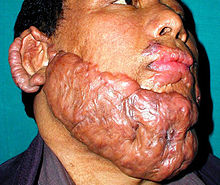Keloid
| Classification according to ICD-10 | |
|---|---|
| L91.0 | Keloid hypertrophic scar |
| ICD-10 online (WHO version 2019) | |
The keloid is a benign tumor that protrudes beyond the skin level and is caused by excessive growth of fibroblasts , which can occur after injuries ( keloid ), operations or spontaneously and is to be regarded as a disturbed healing process. People with dark skin are more often affected than fair-skinned people. The process of forming keloids is known as keloidosis .
The hypertrophic scar is differentiated from the keloid .
Pathogenesis
The cause of keloid formation has not yet been fully researched, but a genetic disposition is certain. The activity of the fibroblasts is influenced, among other things, by growth factors from inflammatory cells and from epidermal keratinocytes . A disturbed interaction of these factors evidently shifts the balance between synthesis and breakdown of dermal collagen .
In contrast to the hypertrophic scar , the keloid can expand beyond the original injury to undamaged skin.
Symptoms
The keloid appears as a bulge-shaped tissue growth raised above the skin level. The color can vary from pale pink to deep red; the consistency is hard-elastic to hard. Preferred locations are the chest, back and shoulder area. Normally there are no symptoms apart from the aesthetic impairment; occasionally itching , sensitivity to touch and dysesthesia may occur.
therapy
The therapy of keloids is difficult, so that several therapeutic approaches are often "tried" in order to achieve a satisfactory result. Well-established clinical results are only available for a few procedures. The level of suffering and thus the patient's readiness for therapy depends on the degree of aesthetic impairment.
Surgical therapy
The sole excision of a keloid with primary wound closure is an obsolete method, as it comes to renewed keloid formation in the scar area. The operation is therefore combined with follow-up treatment (e.g. injection of corticosteroids or interferons ) to prevent the relapse . Other methods are tissue transplants of keratinocytes or the use of split skin .
General drug therapy
A general drug therapy is not yet known. But Japanese researchers reported that patients who were given an antifungal drug ( itraconazole ) to treat fungal infections also experienced dramatic improvements in keloid scars.
Local drug therapy
The local, intralesional injection of corticosteroids (e.g. triamcinolone ) is the most common method of treating keloids. The effect is based on a reduction in collagen production in the fibroblasts. External treatment with creams, ointments or plasters containing corticosteroids is a questionable alternative, because the prompt absorption of the active ingredient in sufficient strength must be questioned.
In addition to corticosteroids, cell growth-inhibiting cytostatics such as 5-fluorouracil or bleomycin are occasionally used.
Occlusion therapy
Another method is to cover the scar tissue with silicone sheets or silicone gel. Occlusion and hydration effects are assumed to be the mechanisms of action.
Cryotherapy
The local application of cold is a complex and lengthy procedure, the effect of which is based on changing the microcirculation in the keloid. In several sessions, the lesion is frozen using the contact or spray method and gradually reduced. A disadvantage is the long healing time after the cold application and the undesirable depigmentation of the skin.
Compression treatment
Local pressure on the keloid also leads to a flattening of the scar after a longer period of therapy. The pressure treatment is usually carried out with compression bandages , occasionally supplemented by plastic masks or snaps at special points. Silicone products that are applied with pressure are also particularly suitable. The therapeutic effect is rather slow, the duration of treatment can be more than two years. The method is also used - with the appropriate disposition - to prevent keloids after operations. The compression treatment has been used successfully for a long time against hypertrophic scars after burns. It must be noted, however, that the quantitatively excessive, so-called hypertrophic scarring pathogenetically does not resemble keloid.
Ionizing radiation
A proven therapeutic approach is the use of ionizing radiation. If a troublesome keloid is surgically removed, the relapse rate without subsequent therapy is very high. When using radiation therapy (e.g. 5 times 3 Gy ), this relapse is prevented with a high degree of probability. Radiation therapy should definitely begin within the first hours after surgical excision of the keloid (it is imperative that the surgeon and radiation therapist coordinate beforehand).
literature
- S2k guidelines for the therapy of pathological scars (hypertrophic scars and keloids) of the German Dermatological Society (DDG). In: AWMF online (as of April 2012)
- Nico Roßmann: Contribution to the pathogenesis of the keloid and how it can be influenced by steroid injections . Jena March 1, 2005, OCLC 179740918 , urn : nbn: de: gbv: 27-dbt-002814-6 .
Web links
Individual evidence
- ↑ Emi Okada, Yu Maruyama: Are Keloids and Hypertrophic Scars Caused by Fungal Infection? . In: Plastic and Reconstructive Surgery . 120, No. 3, 2007, pp. 814-5. doi : 10.1097 / 01.prs.0000278813.23244.3f . PMID 17700144 .
- ↑ Rei Ogawa, Kiyoshi Mitsuhashi, Hiko Hyakusoku, Tuguhiro Miyashita: Postoperative Electron-Beam Irradiation Therapy for Keloids and Hypertrophic Scars: Retrospective Study of 147 Cases Followed for More Than 18 Months . In: Plastic and Reconstructive Surgery . 111, No. 2, 2003, pp. 547-53; discussion 554-5. doi : 10.1097 / 01.PRS.0000040466.55214.35 . PMID 12560675 .
- ↑ Guidelines in Radiation Therapy: Radiation Therapy for Benign Diseases. ( Memento of the original from October 21, 2014 in the Internet Archive ) Info: The archive link was inserted automatically and has not yet been checked. Please check the original and archive link according to the instructions and then remove this notice. Section-specific evidence-based S2e guideline of the German Society for Radiation Oncology (DEGRO) Version 1.0 of November 14, 2013, Chapter 4.3.3: Keloid / Hypertrophic Scars. Pp. 77-78.

